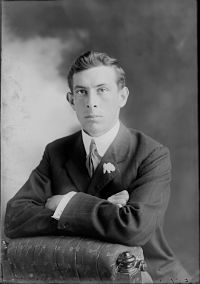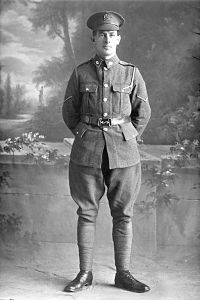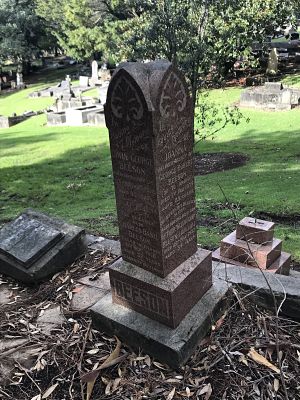WW1 Lance-Corporal Charles Basil Beeson
Lance-Corporal Charles Beeson (Reg. No 26535), also known as Bungee Beeson, was the fifth son of (Edwin) George and Joanna or (Anna) Beeson, of 81 Clonbern Road, Remuera.
Charles was born 12 October 1886 and was educated at Waiorongomai, Te Aroha in the Bay of Plenty and Auckland University 1907-1908. He was one of nine sons, four of whom served in World War I. [1] He did teacher training at Auckland University College (now the University of Auckland) in 1907 – 1908 and prior to enlisting on 19 September 1916 was teaching in Matamata. He was a well known and highly respected resident of the Matamata District, where he took part in local, public and social affairs. He had a keen interest in church matters, being a lay reader for six years and superintendent of the Sunday school at All Saints Church Matamata.
After enlistment on 30 May 1916 at age 29, Charles was quickly promoted to Lance-Corporal and embarked with the 17th Reinforcements to the 4th Battalion, H Company, as part of the New Zealand Rifle Brigade, on 23 September 1916 aboard the ‘Pakeha’, (HMNZT65) to Devonport, Devon, England. [1] After training at Sling Camp, he was transferred to France with the A Company 3rd Battalion of the New Zealand Rifle Brigade. He left for Etaples camp in France in January 1917 but a bout of mumps put him in hospital in St Omer at the end of February 1917. At his own request he also reverted back to the rank of Private in February 1917. [2]
For Christmas 1917, Gladys Jones, a Standard 11 pupil of the Central School, in Taranaki, put a note in the supply of Christmas cakes provided for men at the front, and received a letter of thanks in 1918 from Rifleman C. B. Beeson who expresses grateful thanks for the cake which he voted ‘A1’. He adds: “all the boys send you a big ‘cheerio’ and a good old New Zealand ‘Kia Ora’. [3]
He was detached to the Church Army Hut from 21 June to 3 July 1917 and had 2 weeks leave in England which included attending the No. 3 Company Divisional Training School from 16 January 1918 to 28 February 1918, after which he was reappointed Lance-Corporal.
By early September 1918, in France at Havrincourt, the British First, Third and Fourth armies had pushed the German forces on the Somme back to the Hindenburg Line – the point where the German Army had launched its spring offensive in March. This was now their last line of defence on the Western Front. As the Third Army followed the retreating Germans across the Somme, the New Zealand Division mopped up a succession of rearguards, fighting their way through Havrincourt Forest and Gouzeaucourt Wood before reaching Trescault Ridge. [4]
“The morning of the 8th (of September) broke very cold with a high wind from the south. Whatever hopes the Rifles had of emulating the rapid progress of the 2nd Brigade were doomed to disappointment. There was no abatement of the enemy’s fire, and [New Zealand] posts on the forward slopes under Havrincourt Wood were aggressively sniped and machine-gunned from the high ridge over the valley. It became increasingly manifest that we were at length approaching the main line of resistance.” [5] Charles came close to surviving the war but was killed in action on 8 September 1918 at Havrincourt. He is buried at Gouzeaucourt New British Cemetery, France.
Charles Basil Beeson is commemorated on the memorial cross at St Aidan’s Church, Remuera and on a family memorial at Purewa Cemetery, Meadowbank, Auckland.
Charles’s three brothers also served and survived the war. Sergeant-Major Alfred Victor Beeson was invalided home to New Zealand before the end of the war. Corporal Gordon Ivan Beeson signed up in 1918 but never left New Zealand and Private Ernest Stanley Beeson who was in the United States, enlisted with the United States Aviation Corps. He returned to New Zealand after the war. [6] [7]




